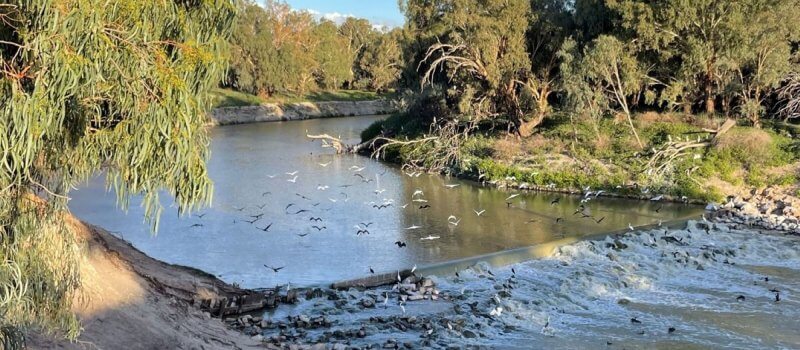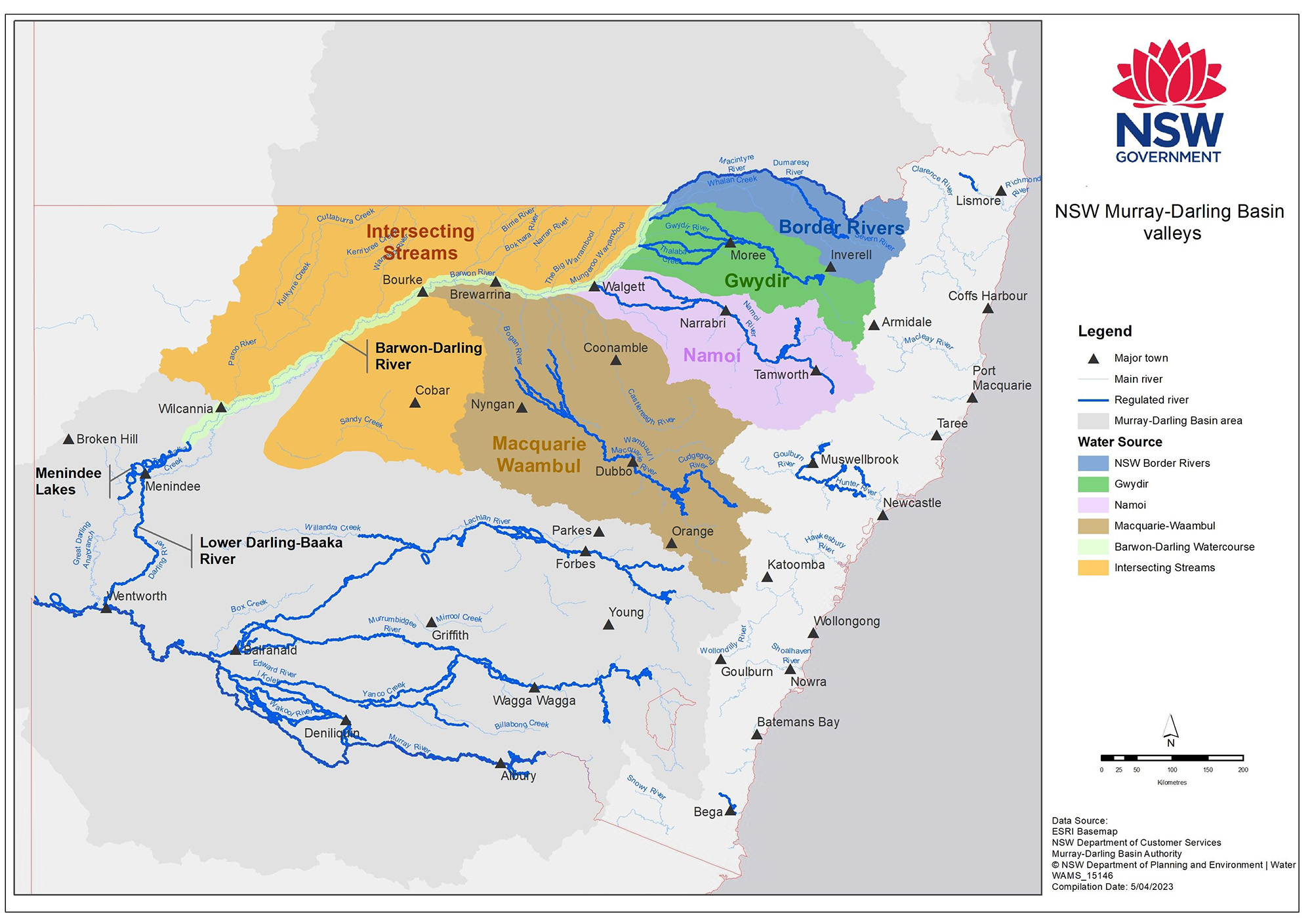About the program
Water flowing across connected catchments supports essential human and ecological needs. The Barwon-Darling River receives more than 90% of its flows from upstream catchments in northern NSW (Border Rivers, Gwydir, Namoi and Macquarie) and Queensland. This mainly occurs during large flows.
The Northern Basin Connectivity Program is undertaking actions to enable water to flow across connected catchments of the northern NSW Murray-Darling Basin and downstream at important times for the following outcomes:
- protect the first flush of water after an extended dry period to protect critical human and environmental needs and support recovery post droughts
- reduce the impact of cease-to-flow periods and improve low-flow connectivity
- support water quality and reduce the risk of algal blooms forming
- support fish migration.
This program builds on the range of connectivity reforms of the NSW Government over recent years including the protection of low flows in the Barwon-Darling, regulating floodplain harvesting, and progressing work on removing unapproved flood works in high priority areas to allow water to flow more easily across the landscape.
Program timeline
-
December 2022
Western Regional Water Strategy released. It identified actions for improving connectivity into the Barwon-Darling in dry times.
-
August 2023
The Independent Connectivity Expert Panel was established to review the department’s analyses and provide independent expert advice to the Minister on the potential for these updated flow targets to meet critical human and environmental needs.
-
April 2024
The panel’s interim findings and recommendations report (PDF. 2,200KB) was released.
-
July 2024
The panel's final Connectivity Expert Panel Report (PDF, 5306.24 KB) was released. The report reflects the views of the panel and is not government policy.
-
September 2024
The department’s Building the pathway to improved northern Basin connectivity (PDF, 350.44 KB)) was released. It outlines what the department will do to consider the Panel’s findings and determine next steps. These will include hydrologic and economic assessments of the panel recommendations, stakeholder consultations, and the implementation of water sharing plan amendments in 2026.
-
December 2024
The department has completed upgrades to the latest version of the hydrologic models (PDF, 105.08 KB) which will improve the ability to model the periods of restrictions required to meet the Panel’s proposed flow targets.
-
February 2025
An interagency Connectivity Regional Working Group was established. As outlined in the terms of reference (PDF, 238KB), the key function of the group is to provide agency expertise by identifying issues and collaborating to consider options for changes to rules to improve northern Basin Connectivity.
-
Now
The department has completed preliminary hydrologic, economic and environmental analysis of the Panel’s recommendations to fully understand the potential benefits and impacts. Results of the preliminary analysis will be discussed with key stakeholders from September 2025.
Next steps
The department has completed initial analysis of potential water sharing plan rules that would result in the implementation of the Connectivity Expert Panel’s recommendations. This is to help understand the potential hydrologic, environmental and economic benefits and impacts of any changes. The department will progressively release the results of the analysis.
It is important to note that recommendations in the Panel’s report were made independent of government and are not government policy. No decision has been made on what steps the NSW Government will take to improve connectivity into the Barwon-Darling River. The findings and recommendation of the Panel are just one of many considerations.
The department is releasing the results of the analysis and will now meet with key stakeholders to discuss findings and hear their input and issues. We will use these discussions and further analyses to help develop government options for improving connectivity leading on from the Panel’s recommendations. These options will be released for consultation in 2026.
Supporting documents
- Analysis of the Connectivity Expert Panel Recommendations: Information paper PDF, 25316.18 KB - brings together key results from four supporting reports that examine the hydrologic, environmental, and economic benefits and impacts of the Panel’s recommendations.
- Assessment of hydrologic modelling PDF, 14360.83 KB - hydrologic modelling that was completed to assess the Connectivity Expert Panel’s recommendations and objectives
- Assessment of environmental water requirements PDF, 20723.26 KB - Environmental water requirements analysis of the Connectivity Expert Panel’s recommendations for improving connectivity in the northern Basin.
- Draft method to categorise priority unregulated water sources PDF, 2282.87 KB - draft method to categorise water sources and determine potential changes to access rules in unregulated water sharing plans.
Subscribe for updates
To be kept up to date with the latest changes subscribe to the mailing list.
While government options to improve connectivity are being finalised, temporary water restrictions may be used to protect the first flows after dry periods to meet critical human and environmental needs. If deemed necessary, these temporary water restrictions would be implemented using Section 324 of the Water Management Act 2000 and may be guided by the critical dry conditions triggers published in the Western Regional Water Strategy.
Northern Basin valleys
Connectivity Expert Panel
Providing independent expert advice
The NSW Government is taking action to improve water flowing across the connected catchments of the northern NSW Murray Basin at important times as part of the Northern Basin Connectivity Program. This work is building on the significant analyses and consultation that occurred as part of developing the Western Regional Water Strategy.
In August 2023, the Hon. Rose Jackson, Minister for Water convened the Independent Connectivity Expert Panel to review the analyses the department has undertaken and to provide an independent assessment of its adequacy.
The scope of the panel’s review can be found in the:
Final report
In July 2024, the panel provided their independent report to the Minister. The report outlines its final findings and recommendations.
In September 2024, the department released the Building the pathway to improved Northern Basin connectivity document outlines what the department will do to consider the Panel’s findings and recommendations and determine next steps.
Download Building the pathway to improved Northern Basin connectivity
The panel's findings have been done independently of government. Updates on what the department is doing to analyse the Panel’s proposed flow targets and determine next steps are above.
Interim report
The panel released a report outlining their interim findings and recommendations in April 2024 and presented their interim findings and recommendations at two public webinars.
Webinars
Frequently asked questions
Panel members
- Ms Amy Dula
Chair -
Director of Programs, Natural Resources Commission - Professor Phil Duncan
First Nations representative, Galambany Professional Fellow, Acting CEO, EPIC CRC - Professor Fran Sheldon
Head of School, School of Environment and Science, Griffith University - Dr Mark Southwell
Principal River Scientist, 2rog Consulting - Dr Phil Townsend
Senior Economic Analyst - Mr Cameron Smith
Principal Water Engineer, Cleah Consulting

